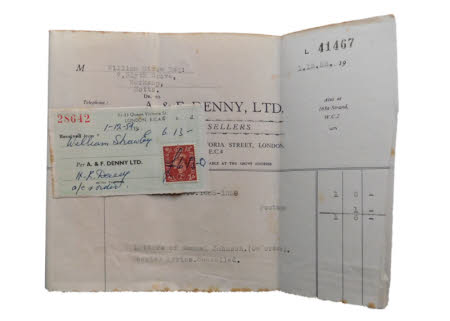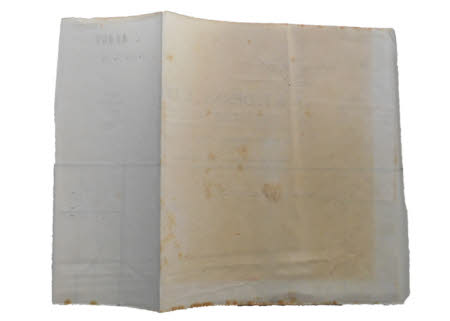Invoice
Category
Ephemera
Date
Unknown
Materials
Paper
Order this imageCollection
Mr Straw's House, Nottinghamshire
NT 3168112.3
Summary
White paper invoice with white paper receipt stuck to it down left side obscuring some of the text. Invoice No. 'L 41467' addressed to 'M William Straw Esq: 7, Blyth Grove, Worksop, Notts.' dated '1.18.52. 19' from 'A. & F. DENNY, LTD.'. a note is typed at the bottom of the invoice 'Letters of Samuel Johnson.(On order). Secular Lyrics. Cancelled.' The back is plain with some discolouration. Receipt No. '28642' addressed 31-33 Queen Victoria St, LONDON, E.C.4' dated '1-12-52' 'Received from William Straw Esq Per A. & F. DENNY LTD.' In the bottom right corner a '2d.' postage stamp with the amount '£6.13.0' written over in blue pen. The invoice is kept in the book 'The earlier Tudors, 1485-1558' by John Duncan Mackie (b.1887) (record 3168112). John Duncan Mackie CBE MC Hon. LLD (Glasgow) (1887–1978) was a distinguished Scottish historian who wrote a one-volume history of Scotland as well as several works on early modern Scotland. Born in Edinburgh, Mackie was educated at Middlesbrough High School and Jesus College, Oxford, where he took a first-class degree in history and won the Lothian Essay Prize. He was appointed as a lecturer in history at the University of St. Andrews in 1909, aged only twenty-two. While at St. Andrews he introduced the subject of Scottish history into the curriculum. During the First World War, he served in the Argyll and Sutherland Highlanders and was awarded a Military Cross. He was wounded in both the stomach and in the shoulder. In both cases he received innovative treatment. For the stomach wound (caused by a machine-gun) he was treated at a military hospital in Rouen. Sterilised water was dripped right through his stomach and he recovered well. The shoulder wound was received in the last days of the war. He nearly had to have his arm amputated but he opted for a new treatment in which the nerve was knotted. However, he never regained full use of his left hand and suffered considerable pain for the remainder of his life. He returned to St. Andrews after the war, before being appointed professor of modern history at Bedford College, University of London, in 1926.

